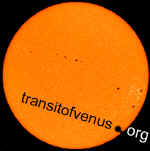Observers across the earth can cooperate to measure the distance to the sun by timing the transit of Venus, just as the international science community conducted global expeditions to time previous transits. Below are links to global observing projects for people of all ages. At a low degree of difficulty, observers simply time the instant of internal contact (when Venus touches the inside edge of the sun) and contribute that timing and their latitude to an international pool of data. At a more advanced level, students time the event and do the math themselves, with the accuracy dependent on how much error you choose to eliminate.
Because these types of sites are growing as the transit nears, we recommend you re-visit them regularly. Several of the projects are listed concurrently on the Education Resources page, along with substantial resources for teachers.
 http://www.eso.org/outreach/eduoff/vt-2004/index.html
http://www.eso.org/outreach/eduoff/vt-2004/index.html
A global observing program in which participants contribute data to determine
the distance from the sun to earth; from the European Southern Observatory (ESO)
and the European Association for Astronomy Education (EAAE).
- http://www.imcce.fr/vt2004/en/fiches_eng.html
Education sheets for teachers. - http://www.imcce.fr/vt2004/en/cdrom_eng.html
CD ROM of historical documents.
 http://www.venus2004.org
http://www.venus2004.org
"To calculate the astronomical unit, two distant people are needed.
These people can exchange their data coming from their observations. Register
and contact other passionate people to work together."
http://www.astronomy.no/venus080604.html
Teacher activities address the circumference of earth, parallax, distance to
the sun, and Kepler's Laws. Site also lists historic background,
visibility times, current research, and more. The organizers in
Norway seek other observers for global project.
 http://www.transitofvenus.co.za/
http://www.transitofvenus.co.za/
Flying With Pride is establishing dissemination points across Africa for
resources related to the transit of Venus; is coordinating direct observing
sites; is planning remote web and television broadcasts; and is planning a
Cape-to-Cairo initiative in which observers along the 28th degree of longitude
in Africa contribute data to determine the distance from the sun to earth.
 http://didaktik.physik.uni-essen.de/~backhaus/VenusProject.htm
http://didaktik.physik.uni-essen.de/~backhaus/VenusProject.htm
"Observing, Photographing and Evaluating the Transit of Venus," a
global observing program in which participants contribute data to determine the
distance from the sun to earth.
 http://eclipse.astroinfo.org/transit/venus/project2004/index.html
http://eclipse.astroinfo.org/transit/venus/project2004/index.html
ProjectVenus 2004 is "an observational project of amateur astronomers to
determine the scale of the solar system with the aid of the Venus transit in
2004. Groups investigate the historical calculations and observations, set up
new procedures, prepare the observation and carry out the evaluation."
http://www.aqua.co.za/assa_jhb/Canopus/Can2000/c00bVnus.htm
Observers in Switzerland seek observers in South Africa for international
project.
http://groups.yahoo.com/group/VenusTransit
The Nehru Planetarium, New Delhi, India, has "started a discussion
group to plan for exchanges of information and observations of the upcoming
Transit of Venus. The group has been formed to make it possible to have an
easy way of having exchanges with students from all over India and also interact
with observers from all over the world."
http://vamana.space-india.org/
Vamana Project is a 3-phase activity in which students in India measure the
radius of the earth using a gnomon; determine the maximum angular separation
between the Sun and Venus; and determine the path that Venus takes across the
solar disc on June 8th.
 www.sunderstanding.net
www.sunderstanding.net
Measuring the Universe with a String and a Stone A series of activities
allow students to measure the distance to the sun simply, with the lone
assumption that Venus is the size of the Earth; from Vivek Monteiro.
 http://usna.edu/Users/physics/huddle/Beat%20the%20Black%20Drop.pdf
http://usna.edu/Users/physics/huddle/Beat%20the%20Black%20Drop.pdf
Jim Huddle of the U.S. Naval Academy proposes "a variation of Halley's
method that avoids the complications of the Black Drop Effect...and requests
collaborators to test the method during the transit of Venus on 8 June
2004." Observers simply photograph Venus at fifteen minute intervals,
noting the times of the photos. (PDF file)
This website makes no endorsement of products or projects listed here. We offer the information as a public service and make no claims about the material to which we link.
